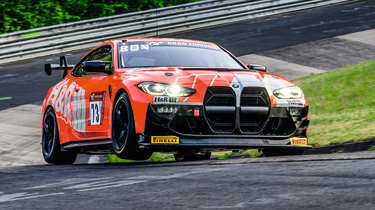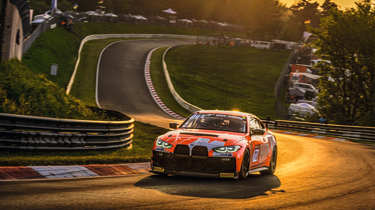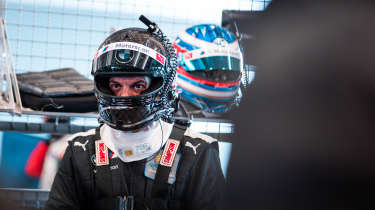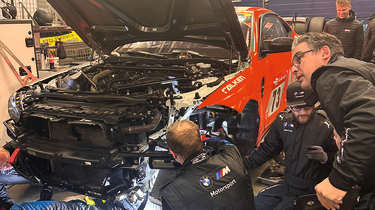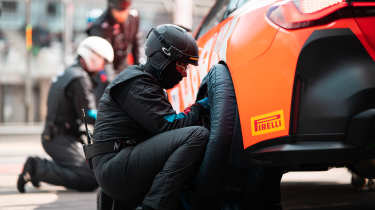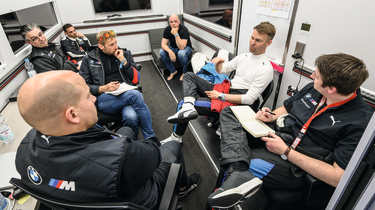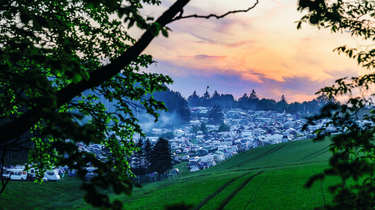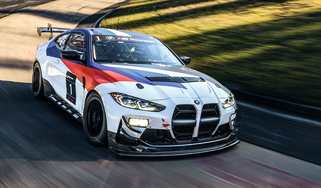When racing at the Nürburgring 24 Hours goes wrong
The Nürburgring 24 Hours is a brutal examination of cars and drivers – and that’s when everything’s going well. When something goes wrong, it’s 24 hours you’d rather forget
Every time I get through the Stefan Bellof ‘S’ unscathed, I breathe a little sigh of relief. It’s a wickedly fast, horribly bumpy right-left-right that rises steeply and then flows back downhill just when you crave a clear line of sight to know you’re on course to nibble the flat concrete exit kerbing. The BMW M4 GT4 is unsettled even before you reach this treacherous section, having just flown over the big jump at Pflanzgarten, and it never fully settles as the rear axle thumps over the ragged surface. The one thing that helps is squeezing the throttle wide open as early as possible. A cruel, taunting realisation and one that severely tests the connection between conscious thought, lizard-brain survival instinct and the muscles in your ankle that pivot your right foot.
Get it right and you’ll need an upshift to 6th halfway through the final right-hand sweep, then rattle over that kerb, feel the M4 get tugged to the left, and tease it back towards the tarmac. Slow hands. It makes sense that this portion towards the end of the Nordschleife is named after one of its true masters. The bravery, technical challenge and calmness required to get it right (or as right as a layman ever can) is exhausting and elating. There are just four corners left before reaching the sanctity of the undulating Döttinger Höhe straight and ticking off another lap. So breathe.
> Nürburgring 24 Hours 2024 to feature 130 car grid, including a Dacia Logan
It’s just after 11pm and I’m reaching the end of the second lap of my double-stint as that exit kerbing rattles the steering wheel. I was fading fast prior to the pit stop, but a big glug of water through the onboard system was wonderfully restorative. The M4 GT4 will go eight laps between stops, where 110 litres of fuel are permitted. Each stop includes a new set of tyres, too: there’s a minimum pit stop time that easily allows fuel, tyres and a driver swap, so it makes sense to get new Pirelli boots whenever possible. The time changes depending on the laps completed in the stint, but for us it’s usually 2 minutes 57 seconds from entry line to exit. Anyway, I feel good and my pace is gently picking up.
The next right-hander requires a sharp braking input, a downshift to 5th, and then you simply roll the car into the apex and sense it hang against the lovely positive camber. There’s so much grip to lean on. I can feel the process even as I recount it. I love this corner – one of the few without an absurd name to bore people with over dinner. But this time I’m a car’s length late on the brakes, a car’s width to the left of that gentle yet assisting camber and as the GT4’s arc becomes more and more out of kilter with the curvature of the track, the reflection of its piercing headlights from the unyielding stare of the Armco is dazzlingly bright.
Front left roars against grass, mud and stones, and the sickening sense that I’m now heading towards an inevitable crash rushes from my feet to my burning-hot temples. Maybe I should spin the car? Save the front and take my chances rotating along the run to the following left… but I’m in 5th at maybe 100mph and there’s high kerbing so close by. Catching one of these ramps and rolling over seems much worse than a simple impact. So I just submit. The Nürburgring takes your options and plans away so fast. Now it’s a question of riding it out and praying the impact isn’t race-ending. Or bone-breaking, come to that.
It’s funny, though. Self-preservation is secondary to the fear of facing the team. Knowing that you’ve just ended their weekend prematurely, or made it a lot tougher along the way. Maybe I can jump out of the car and run into the woods – when the car finally stops scraping along and chewing up the steel guard rail. If only it would stop. The first impact is heavy, ringing my helmet against the side of the seat as the car crunches into the barrier and is thrown momentarily in the air. I’m hard on the brakes and the M4 is slowing, but it feels locked to the steel perimeter – like a Scalextric car in its slot. Eventually it separates and I can guide it back to the track. The race must be over. I radio the team in a very un‑German, highly emotional and probably tearful way. ‘Are you okay?’ comes the reply. ‘Good. Don’t worry. Find a safe place and park the car up.’
‘My’ M4 GT4 is being run by BMW Team RMG alongside their other entrant, the M4 GT3 of the BMW Junior programme. So far BMW has dominated the NLS series at the Ring, winning all three previous races in 2022, and the BMW Junior team of Dan Harper, Max Hesse and Neil Verhagen are dynamite. Probably the pre-race favourites. Seeing the resource, commitment and passion thrown at this project it’s easy to see why the results have come. There’s a calm, thoughtful but ruthlessly competitive edge that runs through every action, every team member, every decision. Team owner Stefan Reinhold sets the standard from the very top. He’s a funny, welcoming presence but the desire to win seems to radiate from every pore. Each car has its own engineering team but Stefan is in the loop on everything and offers advice and an alternative opinion when required.
The calmness of our race engineer, Andreas Gräfer, is expected but incredibly welcome, and I realise that even as he’s instructing me to park up I’m instinctively trying to guide the car slowly back to the box. ‘I’m still running,’ I reply. ‘I think I can make it back.’ The steering is clearly bent, the front-left wheel is scraping against the surface and the dash display is simply all red with the message ‘DSC failure’ written across it. But there’s no steam, no smoke, no fluids dumping onto the remaining three upright wheels. The gearbox is still selecting ratios. The M4 GT4 is severely wounded but it’s alive. Me? I want to die. Just as soon as I deliver car 73 back to the team.
Climbing out of the car once it’s been pushed back into Box 12 is demoralising, embarrassing, gut-wrenching and feels a little bit like an out-of-body experience. People check in on me with reassuring words and then they’re gone, descending on the car in an accelerated but precise way that’s quite something to behold. If anything, the considered, fast-paced approach of Team RMG makes me feel worse. Not only have I caused this mess but I’m helpless to solve it, and now the real professionals can take over. Imposter syndrome – which is always just over your shoulder when you’re a guest driver anyway – eats at my soul. I walk away, quietly change in the team truck and walk back to my hotel. There are 235,000 people at the Ring this weekend. I don’t want to be one of them any more.
How did I get here? It had started so well. The test, featured in evo 310, was truly fantastic. A cold, dry day with the Ring all to ourselves. I went on a mission to find out if I felt comfortable racing there again after a five-year absence and left confident that I was. The pace was there, the car felt easy to handle and the team clearly knew how to look after us all. Driving with M division development driver Jörg Weidinger, Sport Auto Supertest pilot Christian Gebhardt and Auto Bild’s Guido Naumann felt good, and our pace aligned very well. Maybe we wouldn’t be the very fastest crew, but we could be consistently right up there, and with no weak link.
Yet, come race weekend, it was almost immediately apparent that something wasn’t right. Myself and Guido felt disconnected from the car during Qualifying 1 on Thursday afternoon. We’d had a lot of bottoming on that test day and the team was concerned about front splitter wear rates. To alleviate the danger, the car had been raised 4mm and there was a rear anti-roll bar tweak, too. For me these two changes transformed the car from something stable and exploitable to one that felt very nervous at the rear in high-speed corners and massively increased the amount the rear axle was catching air over the bumpiest sections. Jörg and Christian, in contrast, loved it. When something like this happens between teammates it’s really hard to understand. Same day, same track, but a completely different impression.
The night Q2 session is a heart-breaker. The team work hard on the car and I rediscover my confidence, improving massively in terms of pace… but I make two mistakes in four minutes with slow zones. The Nürburgring runs a unique flag system because it’s too long to utilise safety cars. Very simply, it works like this: a single yellow flag signifies possible danger and no overtaking of competitor cars but no speed limit is imposed. Double waved yellows requires a 120kph limit – our GT4 has an FCY (Full Course Yellow) button on the steering wheel to activate a limiter. At this point it’s highly likely that the next marshal post will be holding a single yellow beside a pink reflective board marked ‘Code 60’. For the driver, this means deactivating the FCY limiter and activating the PSL (Pit Speed Limiter), which means 60kph. The end of a Code 60 could be marked with double yellows (revert to 120kph) and then green flags or it could just skip to full green immediately.
It’s a logical system and it keeps the flow of the race going even when there are multiple crashes out on track. However, if you’ve not raced at the Ring for a while then it’s a lot to manage. Imagine driving as hard as you can in the dark on a circuit that constantly heaves and plunges and turns out of sight and into the forest. Now imagine lights from GT3 cars behind, a gaggle of slower cars that you have to pass ahead, plus the stress of just trying to ease yourself back into the frenetic pace of this place. Picking out every flag can be tough. Ironically, my first misdemeanour is on the GP track. I see the double-yellows and get to 120kph but miss the first Code 60 and reduce my speed further at the next post. It sounds stupid but the marshals’ posts are so far away on the GP track, beyond vast gravel tracks, plus you rarely come across Code 60s here: the shunts happen out on the old track. It stings.
The next one is tougher to take. I see the hazard and complete the correct procedures but the limiter doesn’t hold the car at 60kph due to a steep downhill gradient. Just like that, our race is massively compromised. Not only are we forced to start at the back of our group (there are three groups for the rolling start, and our SP10 class for GT4 cars is in Group 2) but we’ll also have to serve a two-minute penalty at our first pit stop. In such a tight and big class it could be a killer blow. Worse still is that I’m reminded of the errors almost constantly. We don’t run Q3 on Friday as there’s no point. Then, come Saturday afternoon, we’re not even allowed to roll our car onto the grid for photographs. The team and my fellow drivers don’t say a word, but I know they’re hugely disappointed to be excluded in this way.
The race is a whole different animal, though. We are severely compromised, that’s for sure, but the attrition is high around here and one mistake can lose a team anything from a few minutes to several hours. Jörg takes the start and scythes through traffic, making up a huge number of places and making sure we’re connected to the GT4 train. The two-minute penalty undoes much of the good work, but it feels like we’ve started on the road to redemption. I’m in second and the car feels phenomenal again. I go for every move, try not to take huge risks and make another ten places in eight laps. Now it’s just a question of keeping up that pace and staying out of trouble. Christian’s stint is limited by a number of slow zones, but he’s flying and setting fastest sectors whenever the car is in free air and the track is green. Guido makes superb progress, too. We’re up to 53rd and moving forwards.
At night there’s a new dimension to the race. The spark showers from Mercedes GT3 cars as they pass and then ride a high kerb or scrape into a compression; the chaos of multiple crashes and slow zones; the spooky feeling of moving off line at really high speeds to pass those awkward competitors who are just a shade slower and have every right to stay on their course. There’s no let-up. Ever. It feels heroic but also deeply and fundamentally ridiculous. The sense that disaster isn’t just lurking but out there in plain sight for every single car on every single corner really does mark out this race. It’s the most intense experience.
For me, if I’m really honest, it feels uncomfortable. I haven’t raced much at all for several years and haven’t been in the thick of it at the Ring for half a decade. It also comes at a time of commitments piling up on top of each other. A few days ago I was in LA and I had just 24 hours at home before driving out to Germany. After the race I have a flight booked to the US again. Before that I’d been at two WEC rounds in three weeks, working for Eurosport. Heap all of these together with family life, writing features for the magazine, recording podcasts and occasionally eating and sleeping, and the circumstances feel like a perfect storm. I should have regretfully passed on the opportunity, but the siren call of this beast of a circuit is strong. Of course, I don’t expect sympathy. This is the dream for so many, myself included. But outside influences really can flip it to a nightmare scenario very quickly.
Back in my room there is no sleep to be had. I check the WhatsApp group marked ‘24h #73’ and, remarkably, the car is repaired and once again circulating at full speed. A new run-plan is sent through and I’m due back in the car at around 10.30am and then for the final stint from around 3.15pm to take the finish at 4pm. My back is agony and I wonder if I’ll even be able to fold myself in. The screen lights up again at 6.13am. It’s Andy, the race engineer. ‘Hi guys. It’s done. Car crashed in Pflanzgarten and is irreparably damaged.’ Thankfully everyone is okay but for all of us and that gorgeous BMW M4 GT4 #73, the 51st running of the Nürburgring 24 is over. Good riddance.
This story was first featured in evo issue 311.

